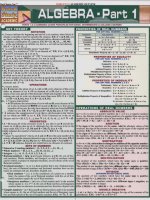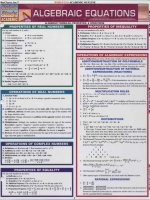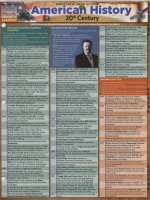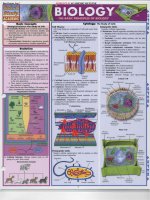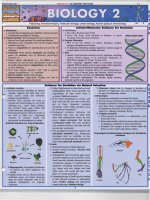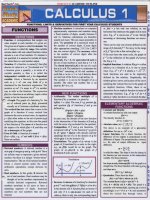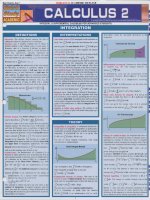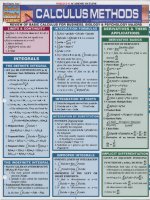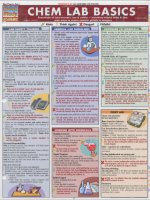Quick study academic algebraic equations 600dpi
Bạn đang xem bản rút gọn của tài liệu. Xem và tải ngay bản đầy đủ của tài liệu tại đây (7.95 MB, 4 trang )
PROPERTIES OF INEQUALITY
For any real numbers a , b , and c:
For any real numbers a, b, and c:
A,Closure
a + b is a real number
I. For addition:
2. For 1l1ultiplication: a • b is a real number
B, Commutative Property
I. For addition :
a + b = b +a
2. For multiplication: ab = ba
C Associative Property
a + (b + c) = (a + b) + C
I. For addition:
a(bc) = (ab)c
2. For multiplication:
D. Identity Property
I. For addition:
a + 0 = a and 0 + a = a
2. For multiplication: a· 1 = a and I • a = a
E. I nverse Property
I. For addition:
a + (-a) = 0 and (-a) + a = 0
2. For multiplication:
a·
A. Trichotomy: Either a = b, a < b , or a > b.
B. Transitive: If a < band b < c, then a < c; also, if a> band b > c, th e n a > c.
C.Addition Property: If a < b, then a + c < b + c; also, ira> b, the n a + c > b + c
for any value of e.
D. Multiplication Property: If c > 0 and a < b, then ae < bc . If C > II and a > b, then ae > be.
Ifc <()and a < b, then ac> be.lfc <0 and a > b, then ae < be. Ife = (), then ac = bc =O.
OPERATIONS OF ALGEBRAIC EXPRESSIONS
A. Like or similar terms are terms with the same variables having the samc exponent values.
ADDITION/SUBTRACTION OF POLYNOMIALS
ax + bx = (a + b)x or ax - bx = (a - b)x; if the variables and ex ponent s arc the sa me.
add or subtract the numbers in front (coctficients) without changi ng the va ri able .
t = I and t . a = I
ADDITION/SUBTRACTION OF RATIONAL
EXPRESSIONS (FRACTIONS)
F. Distributive Property
a(b + c) = ab + ac; a(b - e) = ab - ac; and ab + ac = a(b + c); ab - ac = a(b - c)
G. Multiplication Property of Zero
o • a = 0 and a • 0 = 0
H. Double Negative Property
-(-a) = a or -1(-1· a) = a
---x--;
a
b
a+b·
.
I. x ± x =
If the denol11111ators arc the sa me, add th e numerators on ly.
a
b
ay
bx
ay ± bx " ·1 I '
I
2 . x
± y = .xy ± yx = -----xy; It t lC (enomillators a rc not t l C same,
multiply each fraction by one in the required form, then add the nu merators . If
the denominators arc polynomial, then factorin g the m fi r t w i II he lp determ ine
the least common denominator.
MULTIPLICATION RULES
I. x· x • x ..... x = x" when the number of x va ri able s = n
2. xO = 1 when x .. 0
3. Xl = x
4. xm. x" = xm + " ; also ax lll • bx" = a bx'" + " ; multiply coeffi cients an d variables .
S. (Xlll)" = x m"; also (Xmyl')" = X"H'yP"; powers of powers of monom ials can be
done by mu Itip lying exponents.
Ixl = x if x ,,() and -x if x < O. It is always a positive numerical value.
Ixl = I-xl
3. Ixl" 0
4. Ix - y l = Iy - xl
B. Addition: If the signs of the numbers are the same, add. Ifthe signs of the numbers
6.
are different, subtract. In both ca ses, the answer has the sign of the number with
the larger absolute value.
C Subtraction: Change subtraction to add ition of the opposite number, then follow
the addition rules.
D. Multiplication: Multiply the numbers, then detcrmine the sign of the answer.
Re me mber: negative· negative = positive; positive· positive = positive;
negative· positive = negative; positive· negative = negative; if the signs are the
sam e, the answer is positive; if signs are different, the answer is negative .
E. Divisio n: Divide the numbers, then determine the sign of the answer using the same
(Yx)'" =
ym
X 11\
7. II' a" = a V , then
8. I f a"
=
1/
= v.
b" for a .. 0, then a
=
b.
DISTRI BUTIONS
I. Type I: a(x + y) = ax + ay; a(x - y) = ax - ay
2. Type 2:
a. (a + b)(x + y) = a(x + y) + b(x + y) = ax + ay + b x + by
b. This type, 2 terms times 2 terms, ca n also be cione us ing the FO I L rul e:
First term times first tcrm , Outer term timcs o ute r term, In ner te rm times
inner term, Last term timcs last term, (a + b)(x + y).
3. Type 3: (a + b)(x + Y + z) = a(x + y + z) + b(x + Y + z) = ax + ay + az + bx + by + bz
sign rules that apply to multiplication.
4. Thc Binomial Theorcm: The expansion of( x+y)", where n is a coun ting number,
is a.x"
OPERATIONS OF COMPLEX NUMBERS
+ a 2 x n- 1y + a)xn-Zy2+.•. + an_txyn-I + anyn when:
a l " a 2• 3 y
'0',
an arc
found in Pascal's triangle:
I
I
FI
A. Definition: a ± bi where a,b E Real numbers and i =
B. Addition: (a ± bi) + (c ± di) = (a + c) + (b ± d)i ,
C Subtraction: (a ± bi) - (e ± di) = (a - c) ± (b =+= d)i
D. Multiplication: (a ± bi)(c ± dt) = (ac =+= bd) ± (ad ± bc)i
E. Division:
a±bi
a±bi c =+= di
(ac=+=bd) ± (ad±bc)i
c±di = c±di' c=+=dj =
c'±d '
2
3
4
5
. .
3
4
6
10
10
5
I and so on ...
S. The BII101111al Formula: (x+y)" = x" +
II x"- Iy +
T
n(n-I)
I, 2
"
x"--y- + ... +
n(n-1)(n 2) ... (n - r+ I) nor r
II
I ' 2 ' 3... r
x y + ... + Y
6. The Binomial C oefficient:
A. Reflexive: a = a
B. Sym m etric: If a = b, then b = a.
C Tran sitive: I f a = band b = e, then a = e.
D. Additio n Prope rty: If a = b, then a + e = b + C for any value of c.
E. Multiplication Prope rty: If a = b, then ac = bc for any value of c.
a = ct'
c t hen a d = bc; Ca = ct;
b a
b = c
d: a
c
F. P ro por t'IOn Proper t y: It' 11
a+b
t;
c±d a-b
-d-; a + b
[II]r =
I(
r. n
I~ r.) ,
7. Othcr special types of distributions arc li sted und er the Factors section.
RATIONAL EXPRESSIONS
c
ac
a
I. 11'ct=bd
2.
d
11
c-d
c +d
1
polyno m i a l .
.
polynomial
I
. I l11 ust have all 01 the nUlllcrators a nd dc nOlllllluto rS
polynomial
po yno lllla
factored so identical factors (one in a numerator und the othe r in a deno mi nator)
can be cancelled before l11ultirlyin g.
DIVISION
FIRST DEGREE WITH ONE VARIABLE· STEPS
x± Y
.
I and x ± y = I ; whenever the numerator and denoml11ator are the same
I.
-'xx =
2.
and not zero, the fraction equals on e .
ax
x
= )7;
common factors cancel to equal one.
3.
-II -
1. Simplify the left side of the equals s ign.
2. Simplify the right side ofthc cquals sign.
3. Apply inverse operations until the vari a bl e is iso lated.
4. Note: If the statcment is an inequality and multipli cati on or d ivis io n by a negat ive
number was used to distribute throughout the entire inequality, the n the inequa lity
symbol must be reversed to keep the state ment true and the soluti on correct.
ay
x III
_
.111-11 . ,
x
X
4. ba
II
> nand
111
X III
_
-----n -
c
dc=a
b d
•
= ad
he; I·1'· any
~
1
~
x
X
0
.,
11 m <
It
SYSTEMS OF EQUATIONS
t' tIle numerators or d
'
enol1lmators
are po Iyno
I. A consistent system has one o r more solutions.
2. An inconsistent system has no solution.
3. Methods of solution
a. Linear combination or elimination
I )Put both equations in standard form (alphaheti ca l o rder wi th the constant
on the right s ide of th e equa ls sign).
2)Distribute through one or both cquati ons so th e coe lTic ic nts (nul11bers in
front of th e variables ) of on e of the va riables in both equa tions arc
opposite va lues (same di g its with o ppos ite s ig ns) .
3)Add the two equations (the result wi ll be o ne equ ation w ith o ne variable ).
4)Sol ve the res ulting cquation for the rema ining varia bl e.
5)Put the nume ri cal value for that variable back in to one of the orig ina l
equations and solve for the other va riabl e .
b. Substitution
I)Solve one of the eq uation s lo r on c of the vari a bl e s.
2)Put the rcs ultin g statement into th e other equation in place o f the varia ble
(the resulting equation will have only one va ri abl e) .
3)Solve the equation fo r the num c ri cal value of the va ria ble.
4)Put this numerical value inro e ithe r of the two begi nni ng equa tions a nd
solve for the second variabl e numeri ca l va lue.
c. Graphing
I )(jraph each equation on the coorc!i na t pl a ne.
2) Fi nd and label th e poi nt( s) of int ersec ti on, if there arc any.
d. Cramer's Rul e
I )Put both equation s in standa rd form (all habe t ica l o rde r with the constant
on the right side of the equals s ig n): ax + by = c a nd dx + ey = f.
2)bke the coefficients (numbe rs in fi'ont of the va riables ) a nd make a deter
2
mials, like ax 2 ± b, ± e. they mu st first be factored so identical factors can
dx ± ex ± f
be cancelled as indicated in the Multiplication Rules section on page I.
5.
a
b = ba
C
-7
d : comp Iex f"ractlons a re In
. d·Icate d d',vIsion.
..
de = ba • c
d
6.
ad ± eb
~
a
e
ad
eb
b ±d =bd±bd
e
g
eh
gl'
T±ll fil ± Tt1
eh
±gr
-
r- h
ad ± eb . eh ± gf
ad ± eb
=~~--f-h-=~' eh
I'h
±gr
I'h (ad ± eb)
bd (eh ± gf)
NEGATIVE EXPONENTS
J.
X-III =
-k and -h
x
xln
=
X
2. (x ± yr m =.
(x
I
± y)
'"
and
(x
± y)
'" = (x ± y)"'
FRACTION EXPONENTS/RADICAL EXPRESSIONS
I. a ~
2.
=
rVaW and IVaW =
'V;; =
a*
I
a /I where b" = a; i r n is even and a < 0,
and if n is even and a " 0 ,
3.
'Va" =
'V;;
'V;;
is not a real number,
is the nonnegative number b.
I I
a; (a" )+. = a * = a' =a ifn is ml and a ifn is even, and ( a+'
4. (ax)7--= ·V(ax) lH= nja ll1 Xlll =
r
= a *=a' =a
rv;m. ' R;a nd ,v;m. 'R= IVa III xlll=(ax)*
minate of the system of equati ons. J) =
5.
(ax)~ = 1(ax)+']", = ,~ ; and
6. (ax
± by) ~
7. (XII')' ) +' =
y
= 'V(ax
,,~
=
Vy
I'
±
'V(ax)'" = l(ax)+'1'" =
(ax)~
3 )Tilke the dete rminate of rhe syste m th at was j ust created a nd re pl ace
the coe fficients of one varia ble with th e const an ts of th system ( this
by)'" BUT it docs NOT equal 'v(ax)'" ± 'V(by)'"
is the determinate of that variab le ), D , =
I ~ ~I·
minate of the other variabl e ), J) , =
'R =" ~ = (~
.,,,)·,"
IV?
5 )So lvc each deterl11inate hy findin g th ~ di lTe rcnce 01' the cross product.
V? \ yP
9. '~=llrl~
, ~: ~ , .
4)Take the ori g inal determinate of th e syste l1l a nd re p lace the coe ffic ients
of the other va riable with th e consta nt s of the system (th is is the de ter
'-':; = x:: BUT if the exp ress ion is to be written in
It' Y P
YII
simplest form, a radical expression cannot be len in the denominator.
S.
,~ ~ ,.
, ~ ~ I = ad-eb.
FACTORS
I. Linear Factor Theorem: A polynomial of degree /I " I can be written as the
product of /I linear l~lctors, P(x) = a(x - I",)(x - 1"2)"'(X - r ll ) .
2. Greatest common factor: ax ± ay = a(x ± y)
3. Quadratic trinomials:
a. Xl ± bx ± c = (x + h)(x + k) where h • k = c and h + k = b ; hand k can be
either positive or negative numbers.
b. ax l ± bx ± c = (mx + h)(nx + k) where a " I and m· n = a , h • k = c,
m • k + h • n = b; m . n, h , and k can be pos itive or negative numbers.
4. Perfect square: Xl ± 2xy + yl = (x ± y)(x ± y) = (X ± y)l
5. Perfect cube: x 3 ± 3xly + 3xyl ± y3 = (x ± y)3
= (x + y)(x - y)
6. Diffe rence of two squares: Xl - yi = Xl + xy - xy
7. Sum of two squares: Xl + yl = (x + YI)(x - YI), where;", / - I and is an imaginary number
+ yl)
8. Difference of two cubes: x.1 - Y" = (x - Y)(XI +
9. Sum of two cubes: x 3 + y.1 = (x + Y)(XI - xy + y )
10. Grouping
a.2 - 2 grouping: ax ± ay ± bx ± by = a(x ± y) ± b(x ± y) = (a ± b)(x ± y)
b.3 - 1 grouping: Xl ± 2cx + c l - yi= (x ± C)l - yl = (x ± c + y)(x ± C - y)
c. I - 3 groupin g : yl - Xl ± 2ex - c l = yl - (x ± C)l = (y + x ± c)(y - x + c)
I I. Partial-fraction decomposition rules
a. Lin ear factors : For each distinct factor of the form (ax + h)1II in the denom
6)The solutions are x =
... ,
al l
(uxl + hx + C)III
al II
a l II
enclosed within brackets; A
, where
a mi
a 1112
/I
= n um ber of
i..lrnn
columns and 11/ = numbe r of rows.
2. T he dimension is " 11/ by /I "
3. A coefficient m atrix is formed by the coe ffici ent s of one varia bl e of a system
of linea r cquations forming each column of the matrix .
4. An augmented matrix includes the constants of a sys tem of linca r equatio ns
separated by a verti ca l dashed li ne in the matri x.
5. Row operations that transfo rm an a ugl11 c ntcc!lllatrix into an equi vale nt system:
a. Interchange any twO roWS .
b. Multiply every clcmcnt of any row by a con sta nt, C, w here c " o.
c. Replace every c le ment of a ny row by the slim of itse lf a nd a corre
sponding clement of any ot her row.
d. Gauss-Jordan elimination applies the row operat ions to a n augmented
matrix until all clements of the matrix, xccpt the constants. are zeros and
ones, with the ones I(Jrllling a diagonal from up per-l fl to lower- rig ht. The
solutions of the system arc then the consta nts that co rrespond to the coefficient
A+I b +
A2
ax
(ax + b)2
denominator Q(x), introd uce the sum of m partial fractions
a l2
a 21
A m are constants.
b. Quadratic factors: For each distinct factor of the form
~.
MATRICES & LINEAR SYSTEMS
'1
+... + (ax A+ liib )'" w Ilere A I' A I'
a nd y =
I. A matrix is a rectangular a rray of rea l numbe rs, call ed en tries o r clements.
-;...i
inator Q(x), introduce the sum of 11/ partial fractions.
~'
in the
A IX + BI +
ax 2 + bx + e
Azx+B 2
+ +
A",x+B",
h
A A
A
dB B
(ax 2 +bx+c ) 2 ... (ax2+bx+c)lI1were I' 2' ••• ' man
l' 2'
I ()
values that arc the ones; so, [ () I
()
..., Bn, are constants.
2
()
0:0: e l j mean, x = cpJi = c
C1
I ,'
CJ
2'
and ~ = c J .
A. The x-axis is horizontal; the y-axis is vertical.
B. Each poin t is named by an orde "cd pai r, (x, y) .
I) Equal matrices have the same dimensions and equal corresponding
clements.
2)The sum of two matrices is found by adding the corresponding elemcnts
C. The dista nce between two po ints is d =
of the matrices.
D. The midpoint of a line segme nt with e nd points (x " Y,) and (x z' Yz) is P(.>:, y) where
3 )Scalar multiplication is accomplished by multiplying every element of
X,+X2
d
Y' +Y2
x= - 2- an y = --2-'
the matrix by the scalar c.
4 )Thc diffe rence of two matrices is obtained by subtracting every corre
E. A relation is a set of ordered pa irs.
~~ A functi on is a relation that has no x-values that are the same.
I. j(x) is read "fofx " or "the fll l/ctiol/ (jrx"
sponding element of the matri ces .
S)The product of two matri ces can be found only if the number of columns
2. (r + g)(-.:) = f(x) + g (x)
3. if - g) (.'1;) =I(x) - g(...:)
4. (rg)(x) = /(.>.:) • g(.!;)
S. (r /g)(!;) = j(x) / g (...:)
6. g /j(x)/ = g 'if.f(x)
of one matrix equals the number of rows of the other, and the number of
rows of one equals the number of columns of the other; then, the elements
of each row of one are multiplied by the elements of the columns of the
other matrix, and thesc products are added to result in one number that is
C. Vertical line tes t of a funct ion: A g raph represents a function if and only if no
one element in the product matrix.
vertical line intersects the graph in mo re than one point.
H. A on e-to-one funct ion is a fun ct ion that has no y -valucs that are thc sal1lc.
6)/\ determinant is a number c a lculated Ii·om a square matrix (matrix with
the sa mc number of rows and columns), like
I~
~ I = ad - bc.
POLYNOMIALS
7)The cofactor of the element a i; is the minor of the clcment I'ij multiplied
I. Form : .f(x) = anx n + an_lxn-t+.. . + a tx+a o for rea l numbers; a, w ith an '" O.
by (_ l)i+j.
2. Restri c tio ns on th e coordi nate values may bc nccessary for the polynol1lial to be
a functi o n.
3. Intermediate Val ue Theore m: Ira < b andf(x) is a polynom ial function such that
8)Expansion by cofactors is evaluating a determinate by forming the sum
of the products obtained by multiplying each element of any row or any
column by its eofilctOr.
.f(a) "'j(h) , then f takes every va lue bctwccnf(a) and.f(b) in the interval la, b J.
9)Cramcr 's Rulc is discussed on page 2 in Systems of Equations.
4. The graph of a po lynomia l fun c tion of degree l/ has at most l/ - I tu rni ng
p oints.
SECOND DEGREE·QUADRATIC &
S. Inverse func ti ons, f -' (...:) , are found by cxchangi ng the x and the)' variables in
POLYNOMIAL EQUATIONS
the equa tion;f-'/J(x)j = x for eve ry x in t he do main, and jlf -' ()~ / = y for every
y in the ra nge .
6. Rem ai nder Theorem: If th e po lynomial P(...:) is divided by x - ,', the remainder
is Per) .
7. Factor Theo rem : The poly nomi al P(...:) has a facto r x - ,. if and only if P(r ) = 0
and r is a root.
I. One variable
a. Methods
I )Factoring
i. Usc inverse operations to set the equation equal to zero
ii. Factor
iii .Set cach I~lctor equal to ze ro
jv. So lve each resulting cquation
2)Quadratic Formula
I. Usc inverse operations to set the equation equal to zero.
ii . Apply the quadratic formula, x =
integers a nd
-b + /b ' - 4ac
- 2a
' where
tl ,
b,
9. Th e g raph o f the ra ti o na l fun etion j?:..:) =
II
II "
I has
roots among
the complex numbers when a root that is repeated k times is counted k times.
b. Conjugate Roots Theorem: If II + hi, b", 0, is a root of a polynomial of
II "
EXPONENTIAL FUNCTION
c. Descartes's Rule of Signs: If P(x) is a polynomial with real coefficients, then:
LOGARITHMIC FUNCTIONS
I )The number of positive roots either is equal to the number of variations
I. For all pos itive num bcrs a, where a'" 1, )1 = log,,!; ifand only if x =lf".
2. The common logarithm, log x , has a base of 10. so II = 10 in the definition of log.
3. T he natu ral logarithm, 11/ x, has a base equal to the number e; a = e - 2. 71828,
in the definiti o n of log .
4. Properties with II > 0 a nd II '" I
in sign of P(x) or is less than the number of variations in sign by an even
number. a nd
2)The number ofncgative roots ei ther is equal to the number of variations in sign
of PC-x»~ or is less than the number of variations in sign by an even number.
3. Rational Equations
a. S implify the rational exp ress ions on both sides· of the equals signs by getting
a + bI =
CI + dI
has a hori70ntnl asymptote if the
I. Fonn:j(x) = a", where a > 0, II '" I.
2. Inverses o f e xponenti al funct io ns arc logarithmic functions .
I with rcal coetTicients. then a - bi is also a root.
·
II·
I
I1·k e d
enOllllnators
aileI a((lIlg
~ ~:;
degree o f P(x) " the degree of Q(x), and it has a vertical asympto te at x = I; i r
r is a rea l root of Q(x) but not of Pix) .
10. The tests for sy mmet ry of graphs symmetric with respect to the .
a. x -axi s i f repl aci ng y in t he eq uation with -)I results in an equiva lent equation.
b.y -ax is if replacing x in the equat ion with -x results in an cquiHtient equation.
c. o rigi n if rcp lae ing both x with -x andy w ith -)' in the equation rcsults in an
equiva lent equati on .
2. Polynomials
a . Fundamental Theorem of Algebra: Every polynomial of degree
is a rational root in lowest terms, then p is a factor of the
constant term a o' and if is a fac tor of the leading coefficient all.
zero, a x z + b x + c = 0; notice that the a is the coeO'icient o f the
squared term , h is the co tficient of the first-degre e term, and (' is
the constant without a variablc.
at least one root among the complex numbers ; it has exactly
*
~. If the coe ffic ients o f th e po ly nomial P(x) = an x" + an _1x"-'+... +a1x+a o arc
and c arc numbers found in the cquation that you just set equal to
degree
j';x- -_. --x-,)-'-+-(-y-,-- -y-,-)' .
a.
aloga x =
x
b. log.a' = x
c. log"a = I
~
d .log,, 1 = 0
bad
e
b+a
d+c
becomcs ab + ab = cd + cd' then ~ = Cd·
e. If logau = log"v, then u = v.
b. Multiply the cntire equation by the common denominators to eliminate
them . getting cd(b + a) = ab(d + c).
c. Solve the res ulting equation.
f. If log"u = logbu a nd u " I , then a = b.
g.log"xy = logax + log,,)"
f )~ log"x - logaY
i. log" (+)~-Iogax
4. Radical Equations
h.log a (
a. Isolate the radical expression on one s ide of the equation, if possible (if not
possible, put the radical expressions on two opposite sides of the equals sign).
b. Square, cubc, or raise both entire sides of the equation to the needed power
j. logax" = n(log" x), where n is a real number
(thc power that matches the index of the radical).
k.Chan ge of base rul e: If a > 0, a '" I, b > 0, b '" I , a nd x > 0, then
( log . x)
logb x = ( log . b) .
c. Repeat steps I and 2 as needcd until all radical expressions arc gone.
d. Solve the resulting equation.
c. Check the solution(s) back in the original equation because there is a possibility
( l og x)
I. In x = ( log e )
of extraneous roots (solutions that do not make the original equation true).
3
CONIC SECTIONS
3.
The general limn of the equation ofa conic section with axes parallel to the coordinate
axes is Ax2 + B.W + CJl + Dx + Ey + F = 0, where A and C are not both zero,
1. Lines
,
Y I ~Y2
Lly
rise
a. Slope = III = X I ~ X 2 = ~ = riiIl
b. Point-slope form 01' a linea~ equation: y - y / = III(X - x I)'
e. Slope-intercept form of a linear equation: y = IIIX + b, where 111 is the slope
of the line and b is the y-intercept (point where the line crosses the y-axis).
d. Standard form of a linear equation: ax + by = c, where a, b, and c are integers.
e. Vertical lines have the equation x = a, where a is the x-value where the line
crosses the x-axis.
/'. Horizontal lines have thc equation y = a, where a is the ,v-value where the
line crosses the y-axis.
g. Two lines arc parallel ifand only if their slopes are equal ; m l = m 2.
h. Two lines are perpellllicular if and onl1' if their slopes are negative recip
rocals, and m 2 = - nil and m l = - m,'
i. If III > 0, the line is increasing.
j. If 111 < 0, the line is decreasing.
k. If 111 = 0, the line is horizontal.
1. If III is undefined, the line is vertical.
2. Parabolas
a. General equation: y = a(x - h;2 + k (opens up/down), or x = a(I' - k)2 + h
(opens lelilright)
b. Standard form: (x - h)2 = 4p(y - k) (opens up/down), or (y - k)2 = 4p(x - h)
(opens Icft/ right)
c. Where (h. k) is the vertcx. (h. k ± p) or (h ± P. k) is the vertex with p = 41a'
y = k ±p or x = h ±p is the directrix. andx = h or y = k is the line ofsymmctry.
3. Circles
a. General equation: (x - h)1 + (y - k)1 =,2
b. Where (I!. k) is the center of the circle and r is the radius.
4. Ellipses
.
(x _ h)'
(y _ k) '
a. General equation: - - , - + - - , - = I
b. Where (h. k) is the
cel~ter, a is the ~orizontal
:t e = ne where c is a constant
,,=
I
4. The /lth term of an arithmetic sequence is a" = a l + (n-I)d where" is the
common difJerence.
5. Arithmetic Series: The sum of the first II terms of an arithmetic sequcncc with
a / as the first term and" as the common difference is the III" partial sum:
Sn
=.!l
a ) or S n=.!l
2(a
1+n
2 12a I+(n - 1)dl .
6. The
IIlh
term of a geometric sequence with a/as the first term and r as thc
common ratio is an = alr"-I.
7. The terms between the first and the last terms or a geometric sequence are
called the geometric means.
8. Geometric Series: The sum of the first
.
(. 1- r ) .
9. The sum or the terms of an infinite geomctri c scquence with a l as the first
II
II
n!
ODD NUMBERS, EVEN NUMBERS, MULTIPLES
3. Third number = x + 2d, etc .. where d is the common di flcrcnee betwee n a ny two
consecutive numbers in the set.
movement left and right trom
MONEY, PURCHASES
I. V is currency value or purchase price.
2. C is the number of coins. bills. or purchased items.
3. Formula: VIC I +V 2C 2 + ... +V"C" =Vlnlal
MIXTURE, SOLUTIONS
I. V is the volume
2. P is the percent solution or mixture
3. Formula: VIP I + V 2P 2 + ... + V,llI = Vn"al v"lu.Pfinal valuc
WORK
I. W is the ratio of time to complete the job together by a team of people or machi nes
compared to the time to complete the job alone by one person or onc machinc.
2. One, t , represents the whole job.
3. Formula: WI +W2 +",+W n = I
DISTANCE
I. d is distance
2. r is rate or speed
3. t is time as indicated in the rate; for example. miles per hour or mete rs per second
4. Formula: d = rt
5. These relationships can be used depending on the situation descri bed in the problem:
a. d lo = d...,lurning
SEQUENCES & SERIES
b. d l + d 2 = dllll"1
A. An infinite sequence is a function with a domain that is a set of positive integers;
written as a I' a 2' a3' ••• , ai' ... , with each a i representing a term.
B. A finite sequence is a function with a domain that is a set or only II positive
PROPORTIONS & VARIATIONS
1. (I. b. c. and d are quantities specified in the problem.
2. k", 0
,'"r "3' ... , (I,,_i' a/,.
3. Formulas:
fa, = a l + a 2 + ... + am_I + am where k is the index of the summation.
D.lllh partial sum: S" = :t a, = a l + a 2 + ... + a"'1 + a"
=
a. Proportion:
C. Summation:
l "" I
c cross-multiply to
ba = {f;
x
1
k~x; y
d. Combined variation:)I =
f. A geometric sequence or geometric progression is a sequence in which each term
ISBN-13: 978-157222721-7
ISBN-1D: 157222721-4
is a constant multiple of the preceding term ; an = ran_I where r is the constant
911~111,1ll l ~IIIIIIllIIIJllllllllllllillllli I
multiple is called the common ratio, and r = ~ .
" II
factorial" =
11(11 - /)(11 -
I
2)(11 - 3) ... (3)(2)(/); note: O! = t
PROPERTIES OF SUMS, SEQUENCES & SERIES:
+ b.) =
±
I.
:t(a,
2.
fr~~~gr~akO~fntfes
:tal :tb,
L. = I
l
= 1
u.s. $4.95
=
I
l
varies directly as x a nd inve rse ly as :.
" lite: I)u..: III ils
..: han ;1:;.
", )[1J~· n ..cd
Il'm n:ll. usc
IhJ~
QUickStudy .
gujJc. hu! no! ;'" a rcplacmcnl I\)f lhlgtlo!J das,\.lo\)rl
.\U ril: hh r~f l"\ td. "'(, ~lIn h t Ih" f"Jh1It.lh.'" ,a,n ht ~rd
'"
Ir~n,,"lH1..:d
If! 1111'0' h·m,. (If ~
rm:d\aIU"'.lI. "l\:ludll',
flh(>tQo,'('fI\
~,,\
II'\.:..J'"
...... '..,j,ll'
""','lte dn,J ""r,..:\~ 1 '~"'tm. ",Iho""
,Irtln.n..
Of"
"I .111 m'
,.lll
0401
"WI,m pnTll"
put-ll_her C2002. 2005. BarC h8r1a, Inc,
Ir~1In
lilt
at
qUlcKsluay.com
1. = I
feal c:tal
where c is a constant
=
l =
get lid = cb
b. Direct varialion: y = kx
. .
k
c. I nverse vanat,on: y =
E. An arithmetic sequence or arithmetic progression is a sequence in which each
term difJers from the preceding term by a constant amount called the COl1/11/01/
difference; a" = a".1 + d where d is the common difference.
G. II! or
.
1. First number = x
2. Second number = x + d
h) is the equation oCthe asymptotes.
Uk -
r-I
y
PROBLEM SOLVING
rectangle, a is the vertical movement up and down Irom the center to points on
l
I. the sum docs not exi s t.
+ V)" is
xI1-(r-l)
In-(r-I)]!(r-I)!
b is the horizontal movement left and right from the center to the points on the
U
I I=
because if r > I or r
10. The rlh term of the binomial cxpansion of (x
b. Where (It. k) is the cente~ of the rectaRglc that contains no points of the hyperbola,
a is the horizontal movement left and right ll'Om the center to the points on the
rectangle, b is the vertical movement up and down /Tom the center to points on the
rectangle, and y -k= ± ~ (x - h) is the equation of the asymptotes.
(y'~k)' (x-h)'
.
c . General equation: - -,- - - , - = 1 (opens up-down)
.
a
b
..
d. Where (It. k) IS the center of the rectangle that contams no pomts of the hyperbola,
integers; written as
II
term and r as the common ratio, where r ~ I is I ~ r ; when r < I.
,down from the center to points on the ellipse.
e. Additionally, when a > b, then major axis is horizontal and foci are (h ± c.
k); where c 2 = {/1 - b 2 and where a < b, then major axis is vertical and foci
are (It. k ± c), where ("1 = b 2 _ a 2
5. Hyperbolas
"
(x - h)
(y - k)
l '
I f ' h)
.
a. G enera I equatIOn: - - , - - - - , - = (opens et-ng t
%(x -
terms of a geometric scqucncc with a/ as
[al(l-r")]
5,,=
the center to points on the ellipse. and b is the vertical movement up and
the rectangle, andy -k= ±
II
the first term and r as the common ratio and r '" I is the IIlh partia l sum:
CAN. $7.50
Author: S. Kizlik
I
Customer Hotline #
4
1.800.230.9522
6
o
